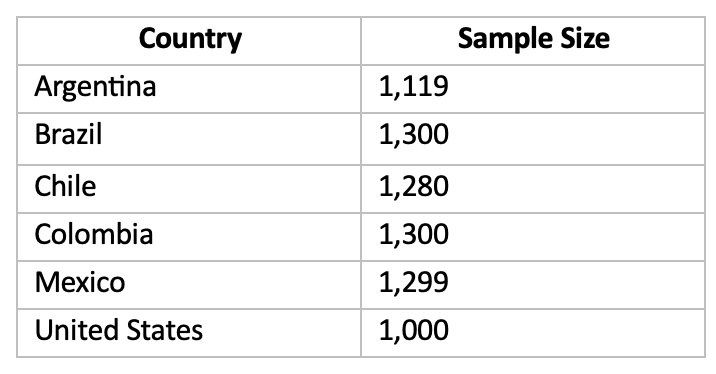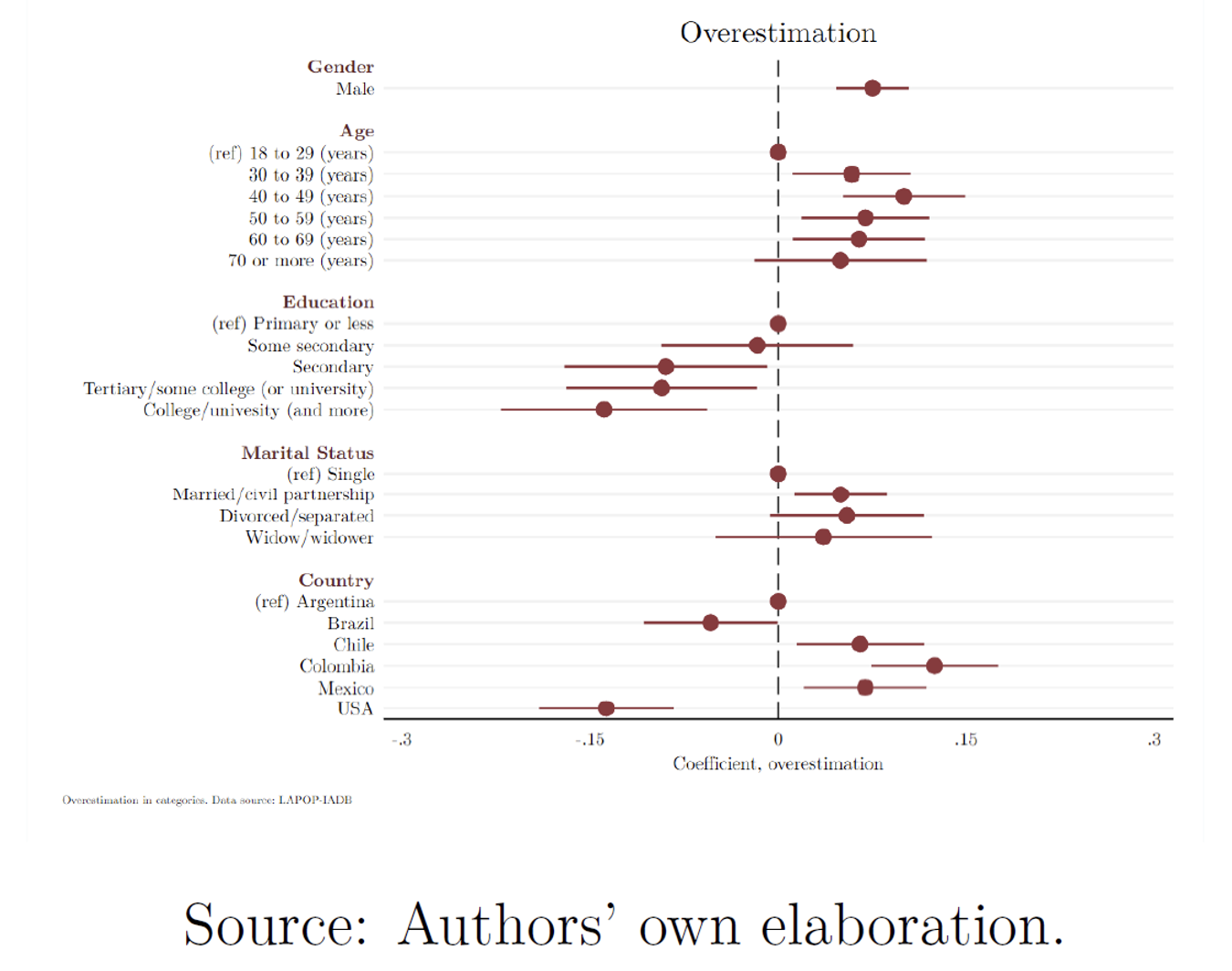Overconfidence and gun attitudes

Context
Overconfidence is observed when people’s subjective confidence in their own ability is greater than their actual performance. It has consequences in a wide range of decision-making processes, leading to risky behaviors. If overconfidence in one’s skills leads to risky behaviors, injuries, and fatalities, it may also affect attitudes toward guns and gun safety. Overconfident individuals overestimate their ability and competence around guns. Similarly, people with positive views of gun ownership are more overconfident in their gun abilities.
In the United States, unintentional shootings cause approximately 500 deaths and 20,000 injuries each year—and disproportionately more in states where weapons may be stored loaded. Ownership and carrying of firearms tend to be correlated with higher levels of gun-related homicide, and firearm-related injuries are the leading cause of death among people ages 1 to 19 years in the United States.
In Latin America, the evidence is similar. Weak gun-control laws, easy access to guns, and greater prevalence of guns are all associated with higher levels of murder, mortality, and violence. Evidence also shows that gun-related homicides are especially high among young people; 80% of all homicides of people between the ages of 10 and 19 years involve firearms.
Project
This study evaluates the relationship between overconfidence and gun preferences using a novel online survey administered to more than 7,000 individuals in Argentina, Brazil, Chile, Colombia, Mexico, and the United States. Each national subsample is representative of the adult population in that nation. Table 1 shows the sample size for each country in this study. The data were collected through an online survey carried out in 2019 by the Latin American Public Opinion Project (LAPOP) and the Inter-American Development Bank (IDB).
Table 1: Sample Size by Country

Behavioral Barriers
Overconfidence: Also called superiority bias. This is the tendency to overestimate or exaggerate our own capacity to perform a certain task. In the context of this study, overconfident individuals overestimate their ability and competence around guns, and people with positive views of gun ownership are more overconfident in their gun abilities.
Optimism bias: Makes us underestimate the probability of negative events and overestimate the probability of positive events. People might underestimate the risks involved in carrying and using guns and overestimate their potential benefit in scenarios such as robbery.
Behavioral Tools
Feedback: It is an effective tool to enhance awareness of the consequences of various choices. It may fill knowledge gaps and foster the search for efficient alternatives. For instance, people who receive feedback that they are overestimating their abilities might adjust their self-assessment for future occasions.
Intervention Design
In this project, the authors test how overconfidence affects the gun-related attitudes and preferences of citizens in the Americas. The main independent variables are overestimation and overplacement, which are also considered in their standardized form or in terms of a principal component for overplacement.
Overconfidence in absolute terms—that is, when people believe that their abilities are greater than they are—is known in the literature as overestimation. Overestimation was primarily assessed by comparing people’s answers to a set of questions with their self-assessment of the accuracy of their answers. In the survey, the authors introduced a set of questions of general interest that would travel well across countries and have no conceivable correlation with gun attitudes. For example, one question asked individuals, “In what country was the singer Rihanna born?” After each question, they were asked to say how confident they felt about their answer. After nine questions, a final question asked respondents about the number they believed they had answered correctly. Overestimation was measured at the individual level i by subtracting participants’ actual score from their self-reported estimate (i.e., overestimation index).
When individuals rank their own skills too far above those of the average person, the bias is called overplacement. Overplacement was measured through the direct method, whereby respondents are asked to indicate how they believe they stand on various dimensions compared with a reference group. Respondents were asked to compare themselves with an average citizen in their country along a set of personal values/attributes: responsibility, ability to make decisions, morality, and responsibility when using weapons. One of the questions was the following: “Do you consider your ability to make decisions to be greater than, equal, or less than that of the average [your country] citizen?”
The dependent variables, i.e., gun-related attitudes and preferences (including ownership), are measured by two sets of questions. In the first set of questions, respondents must indicate their agreement with a series of statements regarding gun ownership and carrying by the police, guards, citizens at home, and citizens in the street. For example, a Likert scale is used to ask respondents about how much they agree with the statement that citizens should be able to carry weapons in the street (Figure 1, panel a).
Figure 1: Gun Preferences

The second set of questions queries the respondents about their hypothetical reactions if faced with different crime situations (Figure 1, panel b). The questions have a similar format but feature changes in context, as follows: “Imagine that you are [walking down the street/you are at home] by [yourself/with your family] at night, and a criminal tries to rob you. You are not sure if your attacker is armed. What would be your reaction?” Participants are asked under which circumstances they would offer resistance to the crime (always resist, resist only if I have a firearm, resist only if I have a knife, never resist). In the main specification, the authors treat each response separately and compare the different options to the baseline of not offering resistance.
Challenges
- Public microdata on the variables considered was limited in availability.
Results
Overall, the authors find that higher levels of overconfidence are positively correlated with permissive gun preferences. They also show that overconfidence is positively correlated with a person’s self-declared inclination to resist a robbery.
- The higher a person overestimates his or her performance in answering general knowledge questions, the more he or she agrees that police, private guards, and citizens should carry weapons.
- Similarly, there is positive and statistically significant relationship between overplacement and all four outcome variables related to carrying weapons. This means that people who overplace themselves are more prone to accept gun ownership and carrying.
- Both overestimation and overplacement tend to increase the probability that an individual would answer that they always would offer resistance or that they would do it with a firearm compared to the probability that they would never do it.
- Figure 2 shows that men are systematically more overconfident than women according to both overestimation and overplacement.
- Similarly, more educated individuals are less likely to overestimate their knowledge, but they are more likely to rate themselves higher than the average citizen on every dimension: responsibility, decisions, morality, and weapons (Figure 2).
Older individuals are less likely to rate themselves higher than average in terms of weapons but more likely to do so regarding responsibility and morality (Figure 2).
Figure 2: Overestimation Index

Policy Implications
- If overconfidence is linked to higher acceptance and willingness to use guns, then voters and their representatives may be making decisions based on a biased assessment of their ability.
- If regulators and politicians do not take into account that individual decision-making and political choices are affected by a behavioral bias, the overall level of guns in society may be higher than the socially optimal level.
- When there is overconfidence, there is going to be an underestimation of the marginal social cost of firearms, which will lead to a lower supply of regulation.
- Given that overconfidence is associated with more risk-taking and fewer safety-oriented attitudes, the positive correlation between overconfidence and gun ownership could explain many accidental deaths and shootings.
- Providing information about actual performance and the risks entailed by wrong choices is a first step towards reducing overconfidence.
Making individuals reflect on their choices–whether legislators, voters, or gun owners–may also help correct observed biases.
